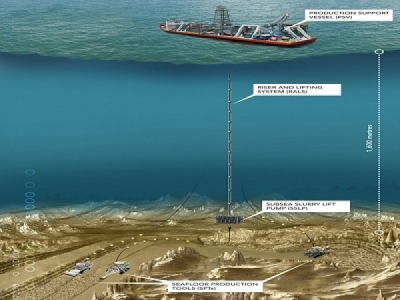
Posted on January 1, 2019
Commercial seabed mining seems imminent, highlighting the urgent need for coherent, effective policy to safeguard the marine environment. Reconciling seabed mining with the United Nations Sustainable Development Goals will be difficult because minerals extraction will have irreversible consequences that could lead to the loss of habitats, species and ecosystems services. A dialog needs to take place around social, cultural, environmental and economic costs and benefits. Governance of human interactions with the seabed is fragmented and lacks transparency, with a heavy focus on facilitating exploitation rather than ensuring protection. In the light of high uncertainties and high stakes, we present a critical review of proposed policy options for the regulation of seabed mining activities, recommend actions to improve seabed governance and outline the alternatives to mining fragile deep-sea ecosystems.
Seabed mining was first mooted in the 1960s, when John L. Mero implied in his 1965 book, ‘Mineral Resources of the Sea’, that manganese nodules grow so fast that the supply would be inexhaustible (Glasby, 2000). Research shows that those estimations were incorrect: marine minerals such as manganese nodules grow at a rate of just several mm to cm per million years (Halbach et al., 1980; Gollner et al., 2017). Commercial seabed mining to target these and other slow-growing deep-sea mineral deposits is now a real possibility. Interest is also growing in metal deposits that accumulate at hydrothermal vents on the seafloor. Mining at vents may become a reality even sooner than on nodule fields. In February 2018, Nautilus Minerals completed trials1 of the deep-sea mining machines it plans to deploy in waters off Papua New Guinea before 2020 and, in March 2018, announced the launch of its seafloor production vehicle2. In September 2017, Japan Oil, Gas and Metals National Corporation and the Japanese Ministry of Economy, Trade and Industry announced that it had completed successful trials of polymetallic mineral extraction from a depth of 1600 m off the coast of Okinawa, Japan (Cuyvers et al., 2018). These two examples indicate the urgency to establish a legal framework to ensure effective protection of the marine environment before commercial activities are considered.
Anthropogenic seabed activities are governed either by the national jurisdiction of a coastal State or, in the areas beyond national jurisdiction (the ‘Area’), by the International Seabed Authority (ISA) (Box 1). The three main seabed mineral resources of interest are cobalt-rich crusts, manganese nodules and seafloor massive sulfides. Within continental shelf areas, additional resources include phosphorites, ironsands and diamonds. No commercial deep seabed mining has yet taken place, but Nautilus Minerals and Diamond Fields International have obtained permits to extract minerals in the Bismarck Sea and Red Sea, respectively. Nautilus Minerals is “committed to developing the world’s first commercial high-grade seafloor copper–gold mine at the Solwara 1 project site in the first half of 2019, subject to further financing”3. At the time of going to press, a spokesperson from Nautilus confirmed that because of finance and other delays, “the timing for initial production at the Solwara 1 Project is expected to be delayed past Q3 2019” (pers. comm., N. Dillane, Corporate Communications Manager. Nautilus Minerals). The Diamond Fields International project to mine the metalliferous muds of the Atlantis II Deep site in the Red Sea is on hold due to a legal dispute.
Source: Coastal News Today





